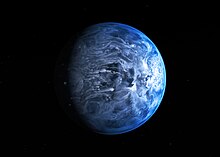Exometeorology
Exometeorology is the study of atmospheric conditions of exoplanets and other non-stellar celestial bodies outside the Solar System, such as brown dwarfs.[1][2] The diversity of possible sizes, compositions, and temperatures for exoplanets (and brown dwarfs) leads to a similar diversity of theorized atmospheric conditions. However, exoplanet detection technology has only recently[when?] developed enough to allow direct observation of exoplanet atmospheres, so there is currently very little observational data about meteorological variations in those atmospheres.
Observational and theoretical foundations
Modeling and theoretical foundations
These models assume that the exoplanet in question has an atmosphere in order to determine its
Recent discoveries and observational foundations
The first exoplanet atmosphere ever observed was that of
However, measuring traditional meteorological variations in an exoplanet's atmosphere — such as precipitation or cloud coverage — is more difficult than observing just the atmosphere, due to the limited resolutions of current telescopes. That said, some exoplanets have shown atmospheric variations when observed at different times and other evidence of active weather. For example, an international team of
Theorized weather

Empirical observations of
However, a number of other observable, non-meteorological properties of exoplanets factor into what exoweather is theorized to occur on their surfaces; some of these properties are listed below.Presence of an atmosphere
As mentioned previously, exometeorology requires that an exoplanet has an atmosphere. Some exoplanets that do not currently have atmospheres began with one; however, these likely lost their primordial atmospheres due to atmospheric escape
Some exoplanets, specifically
Exoplanets with full atmospheres are able to have diverse ranges of weather conditions, similar to weather on the terrestrial planets and
Orbital properties
One of the most important factors determining an exoplanet's properties is its orbital period, or its average distance from its star. This alone determines a planet's effective temperature (the baseline temperature without added insulation from an atmosphere)[7] and how likely the planet is to be tidally locked.[22] These, in turn, can affect what chemical compositions of clouds can be present in a planet's atmosphere,[13] the general motion of heat transfer and atmospheric circulation,[23] and the locations where weather can occur (as with tidally-locked lava worlds with partial atmospheres).
For example, a
Additionally, an exoplanet's average incident stellar radiation, determined by its orbital period, can determine what types of chemical cycling an exoplanet might have. Earth's water cycle occurs because our planet's average temperature is close enough to water's triple point (at normal atmospheric pressures) that the planet's surface can sustain three phases of the chemical; similar cycling is theorized for Titan, as its surface temperature and pressure is close to methane's triple point.[24]
Similarly, an exoplanet's
See also
- Atmosphere and extraterrestrial atmosphere
- Atmospheric circulation of exoplanets; the mathematical models governing exoplanetary air circulation
- Atmospheric physics
References
- ^ Allers, Katelyn (2019-10-10). "Exometeorology: Determining atmospheric ..., Dr. K. Allers". Western Events Calendar. The University of Western Ontario. Archived from the original on 2023-03-14. Retrieved 2023-03-14.
- ^ "Exoplanets subject to meteorological variations". ScienceDaily. Délégation Paris Michel-Ange. 2012-07-10. Archived from the original on 2023-03-14. Retrieved 2023-03-14.
- ^ S2CID 202142065.
- from the original on 2023-03-25. Retrieved 2023-04-15.
- from the original on 2023-03-25. Retrieved 2023-04-15.
- PMID 30636775.
- ^ ISSN 1059-1028. Retrieved 2023-03-25.
- ^ Moran, Joseph M. (1 May 2005). ""Weather"". NASA. NASA & World Book, Inc. Archived from the original on 1 May 2005. Retrieved 3 July 2023.
- S2CID 14487268.
- S2CID 247760051.
- ^ Lewin, Sarah (2017-04-06). "Discovery! Atmosphere Spotted on Nearly Earth-Size Exoplanet in First". Space.com. Archived from the original on 2023-03-14. Retrieved 2023-03-14.
- ^ S2CID 54546633.
- ^ OCLC 957655924.
- ^ from the original on 28 March 2023. Retrieved 15 April 2023.
- ^ Garner, Rob (31 October 2016). "NASA Hubble Finds a True Blue Planet". NASA. Archived from the original on 26 June 2023. Retrieved 31 May 2023.
- ^ S2CID 54038139.
- ^ Gianopoulos, Andrea (3 February 2022). "Puffy Planets Lose Atmospheres, Become Super Earths". NASA. Archived from the original on 26 May 2023. Retrieved 15 April 2023.
- S2CID 239050652.
- ^ a b Bartels, Meghan (5 November 2020). "This bizarre planet could have supersonic winds in an atmosphere of vaporized rock". Space.com. Archived from the original on 12 May 2021. Retrieved 15 April 2023.
- S2CID 119118559.
- ^ from the original on 2021-10-18. Retrieved 2023-04-15.
- S2CID 254369144.
- S2CID 125645319.
- OCLC 1252735501. Archivedfrom the original on 2023-07-24. Retrieved 2023-04-15.
